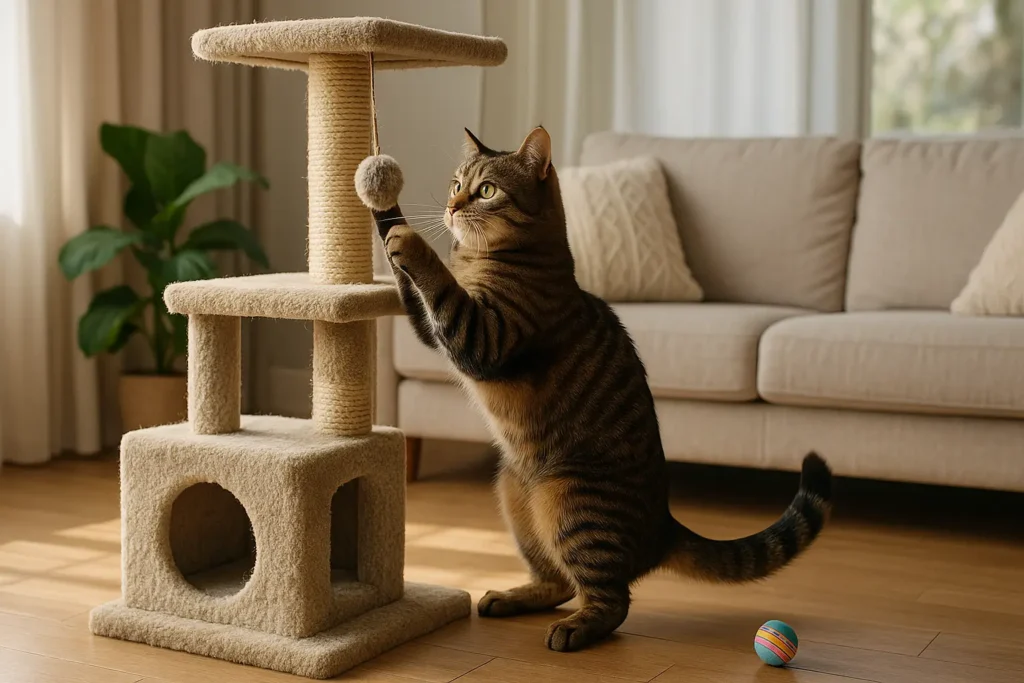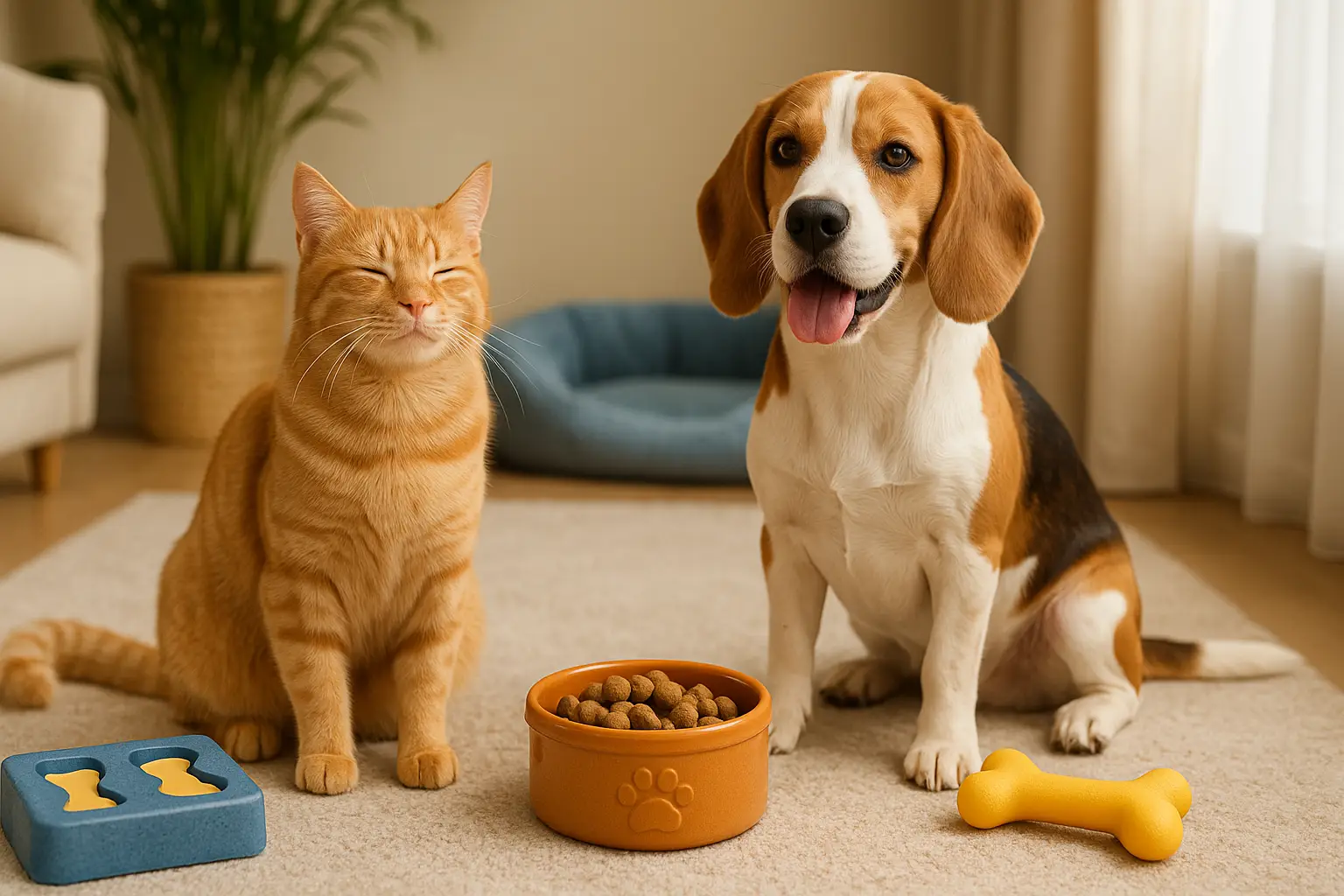How to Keep Your Cat Entertained Indoors Without Destroying the House 🐱
Cats are mysterious little roommates. One moment they’re peacefully lounging on a windowsill like a painting, and the next they’re sprinting across your sofa like a furry tornado. Living with an indoor cat means learning the art of creative enrichment—giving your feline plenty to do, explore, and conquer—without turning your home into a shredded jungle gym.
Contrary to what some think, cats don’t entertain themselves. Indoor cats need stimulation, variety, and challenge. Without it, they can get bored, anxious, and even destructive.
This guide dives deep into how to create a rich, exciting world for your indoor cat—right in your own living room—while keeping your furniture, rugs, and walls intact.

Why Indoor Cats Need Structured Entertainment 🎯
Even the most chill cat has wild instincts. In the wild, cats spend hours hunting, climbing, stalking, and exploring. Indoors, all those instincts are still present—they just don’t have a natural outlet.
When cats don’t get enough stimulation, it can show up in all kinds of frustrating behaviors:
- Scratching furniture
- Nighttime zoomies
- Biting or aggressive play
- Overgrooming or depression
- Destructive curiosity (plants, cords, decor)
Entertainment isn’t a luxury for cats—it’s a basic need.
Understanding Your Cat’s Natural Play Style 🧠
Each cat is different, but most fall into a few classic play personalities. Knowing your cat’s instinct can help you design the perfect play space.
| Type | Description | Best Enrichment |
|---|---|---|
| The Hunter | Loves stalking, pouncing, and chasing | Wand toys, lasers |
| The Climber | Needs vertical space and high-up lookouts | Cat trees, shelves |
| The Cuddler | Prefers soft touch and cozy spaces | Caves, heated beds |
| The Explorer | Investigates bags, boxes, and odd textures | Rotation boxes, tunnels |
| The Wrestler | Plays rough, loves to bite and bunny-kick | Kick toys, plush mice |
✨ WordPress suggestion: Add a personality quiz block so readers can identify their cat type.
Must-Have Toys That Keep Cats Busy (and Out of Trouble) 🎁
Not all toys are created equal. Some get one quick sniff before being forgotten forever. Others become lifelong obsessions.
Top picks for indoor cat toys:
- 🎣 Interactive Wand Toys
Great for bonding and exercise. Move them like prey—fast and unpredictable. Store out of reach when not in use. - 🔦 Laser Pointers
Excellent energy burn. End sessions with a toy or treat to avoid frustration. - 🧶 Catnip Mice and Kick Toys
Satisfy natural pouncing and wrestling instincts. - 🧩 Puzzle Feeders
Turn mealtime into a mental challenge. Prevent boredom and slow down fast eaters. - 🎡 Track Balls or Motion Toys
Great for solo play. Look for ones with flashing lights or unpredictable movement. - 📦 DIY Boxes and Paper Bags
Simple, affordable, and endlessly entertaining. Cut a few holes in a box and rotate weekly.
🔥 Callout Block: “Pro Tip: Keep toys in a bin and rotate every few days to keep novelty high.”
The Power of Vertical Space 🚀
In the feline universe, height equals safety and control. Cats feel more secure when they can observe the room from above.
Vertical enrichment ideas:
- Multi-level cat trees
- Wall-mounted shelves or ledges
- Tall bookcases with safe perch zones
- Window-mounted hammocks
- Staggered shelves for climbing paths
🌿 WordPress Tip: Add a “Vertical DIY Build Guide” with downloadable shelf layout PDF.
Climbing satisfies both mental and physical needs—especially in small spaces.
Create a Window Watch Station 🌇
Windows are like TVs for cats. A well-placed perch can keep them entertained for hours.
How to set one up:
- Choose a window with bird or street action
- Add a ledge, cat hammock, or movable tower
- Place bird feeders outside (but not too close—avoid frustration)
- Add a blanket, scratching post, or bed nearby
🎥 Bonus: Place a motion-activated wildlife cam outside to capture what your cat watches!
Windows offer a safe way to experience the world—and stay mentally stimulated.
Safe Plants for Sensory Play 🌿
Cats love texture, scent, and movement. A small cat-safe indoor garden can enrich their senses and calm their nerves.
Cat-safe plants to try:
- Catnip
- Cat grass (wheatgrass)
- Valerian
- Spider plant
- Areca palm
🪴 Block Idea: “Top 5 Cat-Safe Plants + Care Instructions” with images, watering schedule, and safety tips.
Avoid toxic plants like lilies, aloe vera, pothos, and philodendron.
DIY Cat Entertainment Ideas for Rainy Days ☔
You don’t have to spend a fortune on toys. Some of the best enrichment ideas are cheap—or free.
Fun DIY activities:
- Ice cube chase on tile floors
- Muffin tin with treats under tennis balls
- Cardboard castle made from shipping boxes
- Toilet paper tube puzzle
- Homemade treat scavenger hunts
🧵 Add a “DIY Video Tutorial Block” for each project using WordPress’s built-in embed.
Sometimes the simplest ideas bring the biggest joy.
Taming the Zoomies: Daily Play Rituals 🌀
Cats—especially younger ones—need an outlet for all that pent-up energy. The key is to direct the zoomies, not suppress them.
How to build a play routine:
- Play in short bursts (10–15 minutes, 2–3x a day)
- Use wand toys or chase games before mealtimes
- End with a small treat to simulate a “hunt”
- Stick to similar times daily to build rhythm
🗓️ WordPress Idea: Use a “Weekly Play Schedule” table block with toy rotation and progress notes.
Scheduled play keeps your cat satisfied—and your furniture safe.
Managing Scratching Without Ruining Your Couch 🛋️
Scratching is natural—and necessary. Instead of trying to stop it, give your cat better options.
Effective scratching strategies:
- Provide vertical and horizontal scratchers
- Use sisal, cardboard, and carpet textures
- Place posts near high-traffic or napping areas
- Rub with catnip to encourage use
- Reward when they scratch correctly
💬 Block Suggestion: “Ask a Behaviorist” Q&A—how to stop couch scratching.
Redirect the instinct, don’t punish it.
Litter Box Zen: The Invisible Enrichment 🧼
It might not seem like a source of entertainment, but a clean, private, stress-free litter area improves your cat’s behavior and mood.
Litter box tips:
- 1 box per cat + 1 extra
- Place in calm, accessible areas
- Scoop at least once a day
- Avoid scented litters or drastic box changes
- Rotate box position gently, if needed
🐾 Add a “Litter Box Tracker” block with maintenance reminders.
When litter box stress disappears, behavioral problems often do too.
Rotate, Rearrange, Refresh 🔄
Cats are creatures of habit—but they also love novelty. Keep their space feeling exciting by switching things up periodically.
Try:
- Rearranging towers or shelves
- Rotating bed locations
- Swapping toys or adding new scents
- Introducing new textures or materials
- Updating the view outside the window
🚧 Add a “Monthly Enrichment Rotation” block so readers can stay consistent.
A little change keeps curiosity alive.
Respecting Your Cat’s Pace and Personality 🐈
Not every cat is high-energy or playful. And that’s okay. Respect your pet’s unique vibe and don’t force activity they don’t enjoy.
Signs your cat is content:
- Regular naps in favorite places
- Gentle headbutts or kneading
- Calm eating, grooming, and litter habits
- Occasional bursts of play or curiosity
- Sleeping near you or in sight
When a cat feels safe, they’ll engage with enrichment on their own terms.
💬 Quote Block:
“You don’t train a cat—you earn their interest.”
— Every Cat Guardian Ever
Final Thoughts: A Happy Cat Makes a Peaceful Home 💤
You don’t need to be a cat behaviorist to create an amazing life for your indoor feline. You just need curiosity, observation, and a bit of daily effort.
Keep their minds busy. Give them choices. Offer outlets for climbing, scratching, watching, chasing, and resting. Rotate toys. Talk to them. Laugh with them. Respect their instincts, and you’ll find they respect your home in return.
Because when your cat is enriched, calm, and understood—they don’t need to destroy your plants or wake you up at 3 a.m.
They’re too busy living a good life. With you. Right where they belong.




Post Comment